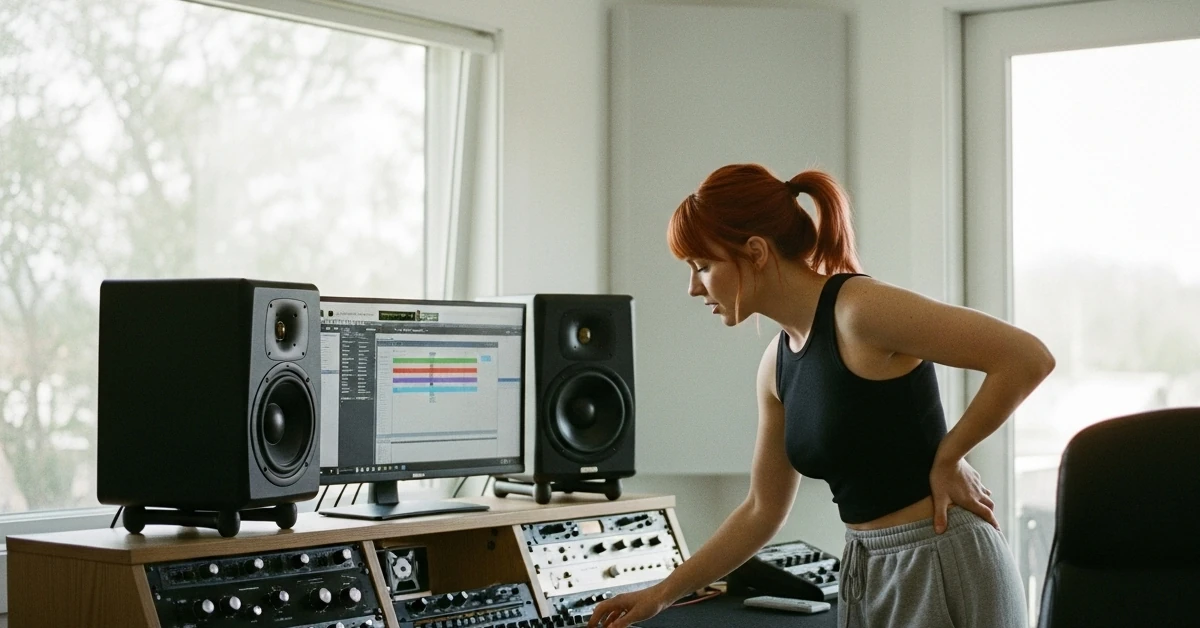Choosing the right studio monitors can feel like navigating a minefield, especially when you’re bombarded with terms like ‘active’ and ‘passive.’ But fear not! This guide will break down the ‘Passive vs. Active Studio Monitors’ debate, making the decision crystal clear.
First, we’ll explore active studio monitors, the all-in-one solutions with built-in amplifiers, perfect for streamlined setups.
Next, we’ll dive into passive studio monitors, which require a separate amplifier but offer greater flexibility and customization.
Then, we will compare active vs. passive studio monitors, highlighting key differences in cost, convenience, and potential upgrades.
Finally, we’ll guide you through choosing the right monitor for your studio, considering your room size, budget, and workflow. By the end, you’ll know exactly which type is the perfect fit for your sound!
Alright, let’s talk active monitors! Think of these as the ‘easy button’ for your home studio speakers. Unlike passive monitors (the other side of the ‘Passive vs Active Studio Monitors’ coin) that need a separate power amplifier, active monitors have the amp built right in. This is a huge deal, especially when you’re starting out or want a clean, simple setup.
Having the amp inside means the manufacturer has perfectly matched the amplifier to the speaker components. This guarantees optimal performance and clarity straight out of the box, without you needing to worry about impedance, wattage, or finding the right amp. You just plug them into your audio interface or mixer, connect them to power, and you’re good to go. Less gear, less clutter, and a more reliable sound for mixing and mastering.
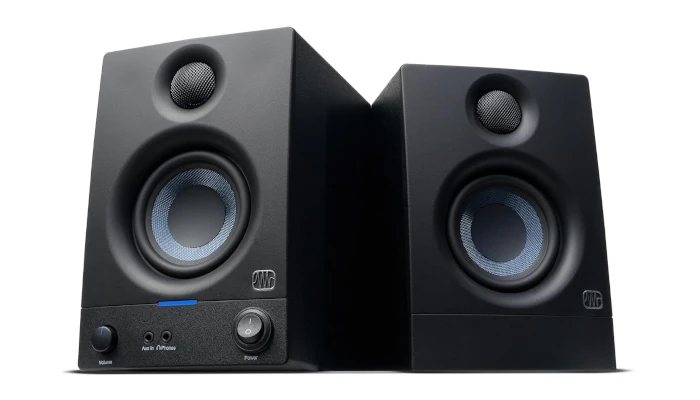
✅ Check Price on Amazon
As an Amazon Associate I earn from qualifying purchases.
Example: Imagine setting up your first home recording studio. You buy a pair of active monitors, an audio interface, and your computer. Instead of needing speaker cables and amplifier cables, you just run standard audio cables (usually XLR or TRS) from your interface’s outputs directly to the back of the active monitors. Sarah, a singer-songwriter, did exactly this. Her setup was up and running in minutes, allowing her to focus on recording and mixing her tracks without complex wiring headaches.
Practical Tip:
- Always connect your active monitors directly to the line outputs of your audio interface or mixer.
- Start with the volume knob on the back of the monitors turned all the way down before turning them on or playing audio. Gradually increase to a safe listening level.
Understanding Passive Studio Monitors
Okay, so you’ve heard about active monitors, which are super convenient. Now let’s look at the other side of the ‘Passive vs Active Studio Monitors’ debate: passive monitors. These guys are a bit more old-school – they don’t have a built-in amplifier. This means you must connect them to a separate power amplifier to make any sound.
Why would you choose passive then? Well, it gives you flexibility. You can pair different amplifiers with different speakers to tailor the sound to your taste or needs. Want a super clean, transparent amp? Or perhaps one with a bit more character? With passive monitors, you have that choice. It also means you can upgrade your amplifier separately from your speakers, potentially spreading out costs over time. It’s a system that requires a bit more gear – speakers, amplifier, and speaker cables – but offers more control over your signal chain.
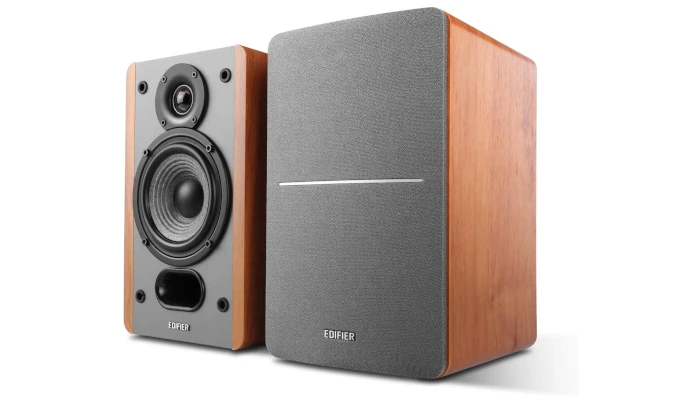
✅ Check Price on Amazon
As an Amazon Associate I earn from qualifying purchases.
Example: Let’s say you inherit a fantastic vintage power amplifier. Instead of letting it collect dust, you could pair it with a set of passive studio monitors. Mark, a producer working with analog synths, preferred the specific warmth of his vintage amp. He chose passive monitors so he could incorporate that amp into his monitoring chain, something he couldn’t do with active speakers. This setup allowed him to get a unique sound from his monitoring system that perfectly complemented his production style.
Practical Tip:
- When choosing an amplifier for passive monitors, make sure its power output (wattage) matches the monitor’s power handling specifications. Too little power can damage the amp; too much can damage the speakers.
- Always use proper speaker cables, not instrument cables, to connect passive monitors to your amplifier.
Active vs. Passive: Key Differences and Considerations
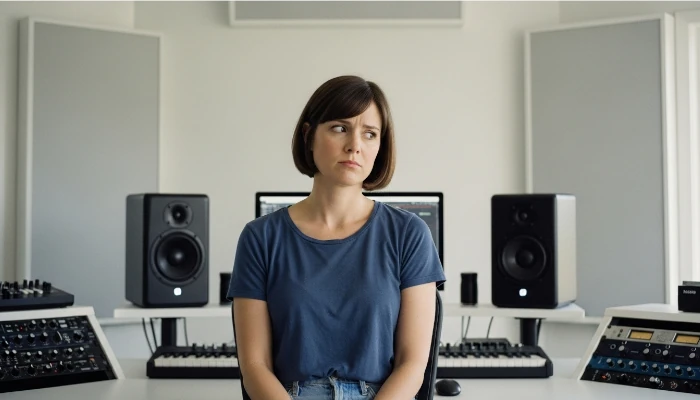
When you’re trying to figure out the ‘Passive vs Active Studio Monitors’ puzzle, the biggest difference boils down to the amplifier. Active monitors have it built-in, making them super convenient and a plug-and-play solution. Passive monitors, on the other hand, require a separate power amplifier to function. This fundamental difference leads to several considerations when choosing the right setup for your home studio.
Cost can be tricky. While a pair of active monitors might seem more expensive upfront than just passive speakers, remember you’re buying the speakers and the perfectly matched amplifier in one package. With passive monitors, you buy the speakers then need to budget separately for a suitable amplifier and speaker cables. Simplicity heavily favors active monitors – fewer boxes, fewer cables, less hassle. Flexibility, however, is where passive shines. You can experiment with different amplifiers to find a sound you love, or upgrade components individually over time.
Example: Let’s look at two friends building studios. David wants the fastest, easiest setup possible. He buys a pair of active monitors, plugs them into his interface, and starts recording the same day. Sarah is on a tighter initial budget but plans to upgrade later. She finds a great deal on used passive monitors and a decent entry-level amplifier. Her setup takes a bit more wiring, but she knows she can upgrade the amp in a year or two for a potentially significant sound improvement without buying new speakers. This highlights the core trade-off in the ‘Passive vs Active Studio Monitors’ choice.
Practical Tip:
- For Simplicity & Convenience: Go active. Ideal for beginners or those who want minimal gear and wiring.
- For Flexibility & Potential Upgrades: Consider passive. Better if you like tweaking your sound chain or plan staged upgrades.
Choosing the Right Monitor for Your Studio
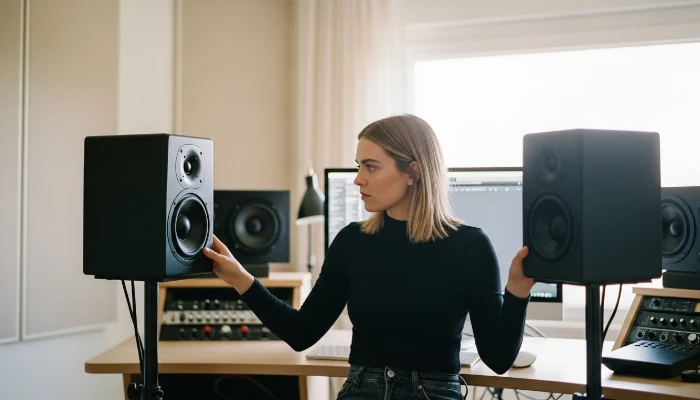
Alright, so you’ve got the lowdown on ‘Passive vs Active Studio Monitors’. But which one is right for you? The answer isn’t one-size-fits-all. Choosing the perfect monitor involves looking at your specific needs, budget, and your workspace. Don’t just buy what your favorite producer uses; think about what makes sense for your situation.
Your room size is a massive factor. A small bedroom studio might be overwhelmed by huge monitors, regardless of whether they’re active or passive. Smaller monitors designed for nearfield listening are often better here. Your budget also plays a huge role. While active monitors bundle the amp and speakers, the total cost of a passive setup (speakers + amp + cables) can sometimes be higher, or you might find better deals on used passive gear. Consider your workflow too: do you want ultimate simplicity (active) or the ability to swap amps for different sounds (passive)?
Example: Let’s look at Maya, who just converted a spare closet into a vocal booth and works in a small bedroom. She needs monitors that fit her desk, sound accurate at close range, and are easy to set up so she can focus on recording. For her, a pair of smaller, active nearfield monitors is the perfect fit. They take up minimal space, require simple cabling, and are designed for the kind of environment she’s working in, making her ‘Passive vs Active Studio Monitors’ decision lean heavily towards active.
Practical Tip:
- Listen in your space: If possible, audition monitors in your actual studio room or a similar environment. How they sound in a store is different from how they’ll sound reflecting off your walls.
- Consider room treatment: No monitor, active or passive, will sound accurate in an untreated room. Budget for acoustic treatment alongside your monitors!
- Match size to room: Don’t buy massive monitors for a tiny room; you’ll likely get inaccurate bass response.
Finding Your Perfect Sound: Active vs. Passive Monitors
So, we’ve journeyed through the world of studio monitors, dissecting the core differences between active and passive setups. Remember, active monitors offer streamlined convenience with their built-in amplifiers, while passive monitors provide flexibility and customization through separate amp pairing. We’ve explored how factors like room size, budget, and workflow preferences play crucial roles in determining the best choice for your unique studio environment.
Ultimately, the ‘Passive vs Active Studio Monitors’ debate has no single winner. The best monitors are the ones that empower you to create your best work. Now that you’re armed with this knowledge, it’s time to put it into action! Research specific models, read reviews, and, most importantly, try to listen to different monitors in a space similar to your own.
Happy mixing!

